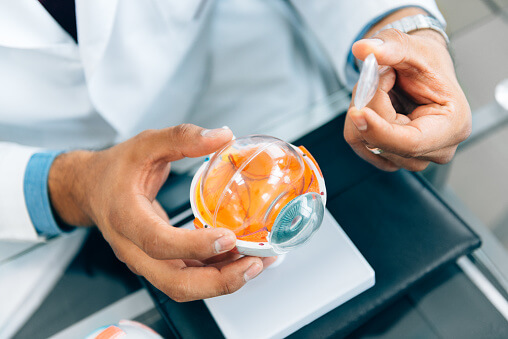
Keratoconus: Know the Signs of This Mysterious Eye Disease
If your eye doctor says you have keratoconus, it’s possible that you’ve had it for years without knowing it. It’s difficult to detect this progressive eye disease affecting the cornea without a specific test. Treatment will depend on how far the disease has progressed when you get your diagnosis.
Mapping the eye
Ophthalmologist William Dupps, MD, PhD, says doctors typically diagnose keratoconus using topography, a test that measures and maps out the curvature of your eye’s surface.
Keratoconus causes the cornea to become thinner and weaker. It changes its shape from round to more bulging and cone-like. Topography allows your doctor to see those changes.
Navigating the condition
Keratoconus can make your vision blurry or distorted (astigmatism) or cause nearsightedness. And it may get worse over time. It usually affects both eyes as it progresses, but can be more severe in one eye. This often leads to late detection because the better-seeing eye often prevents a person from noticing changes in the worse eye.
You cannot reverse the damage, but your doctor can treat it to reduce the impact on your vision, Dr. Dupps says.
Until recently, doctors based treatment options primarily on correcting vision. Treatment typically progresses with the disease, with doctors prescribing:
- Eyeglasses and soft contact lenses for mild cases in the early stages
- Hard or specialty contact lenses for more moderate cases
- Corneal transplant for severe cases (when optical correction alone is no longer effective)
However, newer treatments focus on the cornea instead. “We can treat some forms of keratoconus with surgical implants,” Dr. Dupps says. “Intracorneal rings such as Intacs®, approved for use in 2004, can be inserted into the eyes and help reshape the cornea.”
The big breakthrough, Dr. Dupps says, was in 2016, when the FDA approved corneal cross-linking to treat the disease in its early stages. This non-surgical option focuses on strengthening the cornea with riboflavin and ultraviolet light.
As with other treatments, it won’t reverse the damage. But corneal cross-linking can slow or even stop keratoconus from progressing. You may still need glasses or contact lenses. But your vision is less likely to get worse, he says.
Understanding why the condition develops
Keratoconus usually affects people in their teens or 20s. But, it’s difficult to predict whether you or your kids will get it, Dr. Dupps says.
The exact cause is unknown, but doctors suspect certain factors may play a role:
- It is sometimes hereditary
- It is more likely for those who have Down syndrome and certain other conditions.
- Patients with signs of keratoconus on topography are not candidates for LASIK or many other forms of refractive surgery, which can further weaken an already-weak cornea.
“Long-term rubbing of your eyes also can raise the risk of keratoconus,” he says. So keep your hands away from your eyes as much as possible, he cautions, and treat seasonal eye allergies to reduce the itching that leads to habitual rubbing.
What warning signs should you watch for?
“Because the changes may progress very slowly, the condition is often detected only after significant steepening of the cornea has occurred,” Dr. Dupps says.
Except in advanced cases, you can’t see the effects of the disease with the naked eye. Parents can’t see it in their kids’ eyes. And you won’t see it in the mirror.
However, you may notice possible warning signs in your child’s vision exams over time.
Consider asking your doctor about testing for keratoconus if you notice:
- Your child’s vision worsens from exam to exam (higher amounts of nearsightedness or astigmatism on the glasses prescription)
- Even with corrective lenses, your child’s vision doesn’t improve to 20/20.
Aside from doing what you can to keep your eyes safe, there’s currently no way to prevent keratoconus. Catching it before it does too much damage to your vision is the key, Dr. Dupps says, and the availability of a stabilizing treatment like corneal cross-linking has made it possible to prevent vision loss from keratoconus.



Leave Your Comment